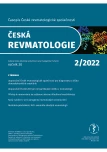EULAR recommendations for intra-articular therapies in rheumatology
Authors:
K. Pavelka
Authors‘ workplace:
Revmatologický ústav Praha
Published in:
Čes. Revmatol., 30, 2022, No. 2, p. 60-66.
Category:
Recomendation
Overview
Pavelka K. 2021 EULAR recommendations for intra-articular therapies in rheumatology The article’s subject is the content of the EULAR recommendations for intra-articular (i.a.) therapy and their commentary. The recommendations were developed according to the established EULAR methodology and published in the organization's official journal. Making recommendations aims to create practical instructions for doctors for intraarticular therapy. An international panel of two principal authors and 12 experts from six European countries was set up. The final document contains five overarching principles and eleven recommendations. These recommendations include adequate patient information, recommended conditions for intra-articular administration, accuracy, aseptic application, and safety. Some recommendations apply to special populations, such as pregnant women or diabetes patients. The use of local anesthetics is also discussed.
After 70 years of using intra-articular therapy, this is the first publication that seeks to standardize and harmonize its technique. The efficacy of individual drugs in various diagnoses is not the subject of this publication.
Keywords:
EULAR – intra-articular therapy
Sources
- Uson J, Rodriguez-Garcia SC, Doherty M, et al. EULAR recommendations for intra-articular therapies. Ann Rheum Dis 2021; 80 : 1299–1305.
- Shea BI, Reeves BC, Wells G, et al. AMSTAR 2: a critical appraisal tool for systematic reviews that include randomised or non-randomised studies of healthcare interventions, or both. BMJ 2017; 358: j4008.
- Richette P, Doherty M, Pascaul E, et al. 2016 updated EULAR evidence-based recommendations for the management of gout. Ann Rheum Dis 2017; 76 : 29-42.
- Hermans J, Biersma-Zeinsta SMA, Bos PK, et al. The most accurate approach for intra-articular needle placement in the knee joint: a systematic review. Semin Arthritis Rheum 2011; 41 : 106–115.
- Geirsson AJ, Statkevicius S, Víkingsson A. Septic arthritis in Iceland 1990–2002: increasing incidence due to i.a. terapierogenic infections. Ann Rheum Dis 2008; 67 : 638–643.
- Weiss JE, Haines KA, Chalom EC, et al. A randomized study of local anesthesia for pain control during intra-articular corticosteroid injection in children with arthritis. Pediatr Rheumatol Online J 2015; 13 : 36.
- Hsu W-C, Wang T-L, Lin Y-J, et al. Addition of lidocaine injection immediately before physiotherapy for frozen shoulder: a randomized controlled trial. PloS One 2015; 10: e0118217.
- Kullenberg B, Runesson R, Tuvhag R, et al. Intraarticular corticosteroid injection: pain relief in osteoarthritis of the hip? J Rheumatol 2004; 31 : 2265–2268.
- Choudhry MN, Malik RA, Charalambous CP. Blood glucose levels following intraarticular steroid injections in patients with diabetes: a systematic review. JBJS Rev 2016; 4 : 01874474.
- Twu J, Patel N, Wolf JM, et al. Impact of variation of corticosteroid dose, injection site, and multiple injections on blood glucose measurement in diabetic patients. J Hand Surg Am 2018; 43 : 738–744.
- Russell SJ, Sala R, Conaghan PG, et al. Triamcinolone acetonide extended-release in patients with osteoarthritis and type 2 diabetes: a randomized, phase 2 study. Rheumatology 2018; 57 : 2235–2241.
- Kaandorp CJ, Dinant HJ, van de Laar MA, et al. Incidence and sources of native and prosthetic joint infection: a community based prospective survey.Ann Rheum Dis 1997; 56 : 470–475.
- Guillén Astete CA, Terán Tinedo M, Quiñones Torres JR, et al. Safety of joint puncture in patients receiving anticoagulant therapy with dabigatran. Reumatol Clin 2017; 13 : 368–369.
- .Spyropulos AC, Douketis JD. How I treat anticoagulated patients undergoing an elective procedure or surgery. Blood 2012; 120 : 2954–2962.
- Ahmed I, Gertner E. Safety of arthrocentesis and joint injection in patients receiving anticoagulation at therapeutic levels. Am J Med 2012; 125 : 265–239.
- Yui JC, Preskill C, Greenlund LS. Arthrocentesis and joint injection in patients receiving direct oral anticoagulants. Mayo Clin Proc 2017; 92 : 1223–1226.
- Werner BC, Cancienne JM, Browne JA. The timing of total hip arthroplasty after intraarticular hip injection affects postoperative infection risk. J Arthroplasty 2016; 31 : 880–883.
- Mills ES, Elman MB, Foran JRH. The risk of acute infection following intra-articular corticosteroid injection into a pre-existing total knee arthroplasty. J Arthroplasty 2018; 33 : 216–219.
- Klement MR, Luzzi Aj, Siddiqi A, et al. Intra-Articular corticosteroid injection following total knee arthroplasty: is it effective? J Arthroplasy 2019; 34 : 303–308.
- Raynauld J-P, Buckland-Wright C, Ward R, et al. Safety and efficacy of long-term intraarticular steroid injections in osteoarthritis of the knee: a randomized, double-blind, placebo-controlled trial. Arthritis Rheum 2003; 48 : 370–377.
- McAlindon TE, LaValley MP, Harvey WF, et al. Effect of intraarticular triamcinolone vs saline on knee cartilage volume and pain in patients with knee osteoarthritis: a randomized clinical trial. JAMA 2017; 317 : 1967–1975.
- Altman R, Hackel J, Niazi F, et al. Efficacy and safety of repeated courses of hyaluronic acid injections for knee osteoarthritis: a systematic review. Semin Arthritis Rheum 2018; 48 : 168–175.
Labels
Dermatology & STDs Paediatric rheumatology RheumatologyArticle was published in
Czech Rheumatology

2022 Issue 2
Most read in this issue
- Approach to a patient with elevated serum creatine kinase
- Recommendations of the Czech Society for Rheumatology for the diagnosis and treatment of giant cell arteritis
- IL-40 – a new cytokine in the pathogenesis of rheumatic diseases
- Abstracts of the XVIII. seminar of young rheumatologists (Mikulov, May 26th–28th 2022)
